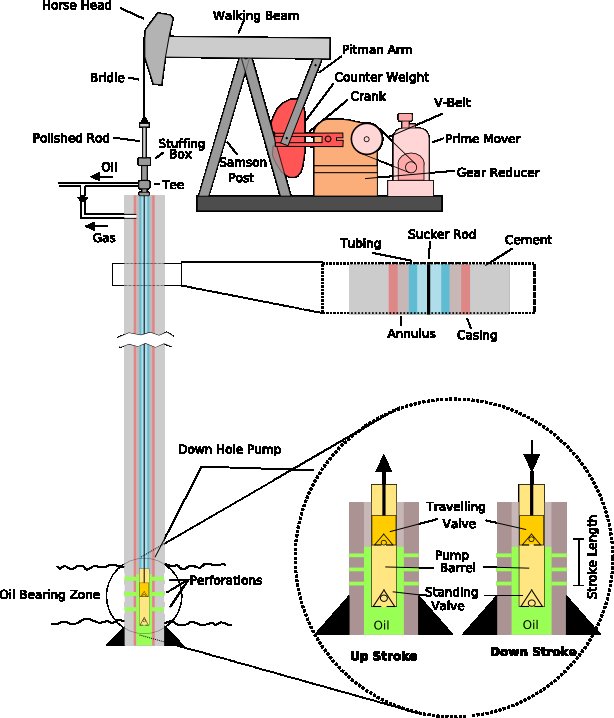An oil pump jack operates by harnessing the power of a reciprocating piston to draw oil from deep underground. This iconic mechanical structure is a staple of the oil extraction process, tirelessly bobbing up and down as it pumps out valuable crude oil. The rhythmic motion of the pump jack symbolizes the heartbeat of the oil industry, tirelessly working to bring precious resources to the surface. Let’s delve deeper into the fascinating realm of oil extraction and uncover the intricate mechanisms behind how does an oil pump jack work.
Exploring the Wonders of an Oil Pump Jack
Welcome, curious minds! Today, we are embarking on an exciting journey to unravel the mystery behind the workings of an oil pump jack. Have you ever passed by a vast oil field and wondered how those massive machines tirelessly extract oil from deep within the Earth? Well, get ready to dive into the fascinating world of oil extraction as we delve into the intricate mechanisms of an oil pump jack.
The Basics of an Oil Pump Jack
Before we jump into the nitty-gritty details of how an oil pump jack operates, let’s start with the basics. An oil pump jack, also known as a nodding donkey or a pumpjack, is a common sight in oil fields across the world. These towering structures play a crucial role in extracting oil from deep underground reservoirs.
At its core, an oil pump jack consists of several key components that work together seamlessly to bring the precious liquid gold, also known as crude oil, to the surface. The main goal of an oil pump jack is to create the necessary mechanical force to lift oil from a well and transport it to the surface for further processing.
The Role of the Prime Mover
One of the essential components of an oil pump jack is the prime mover. The prime mover is the powerhouse of the operation, providing the necessary energy to drive the pumping mechanism. In most cases, the prime mover is either an electric motor or a gas engine that converts energy into mechanical power.
When the prime mover is activated, it sets the entire system in motion, initiating the extraction process. The prime mover’s role is akin to the heart of the oil pump jack, pumping life into the operation and ensuring a continuous flow of oil from the well.
Understanding the Pumping Unit
Another critical component of an oil pump jack is the pumping unit. The pumping unit is responsible for the up-and-down motion that drives the extraction of oil from the well. This rhythmic motion, often described as nodding, gives rise to the nickname “nodding donkey.”
Within the pumping unit, there are various mechanical components, including a walking beam, horsehead, pitman arm, and bridle cable, all working in harmony to draw oil from the depths of the Earth. The synchronization of these components is crucial to ensure a smooth and efficient pumping process.
The Walking Beam
Central to the pumping unit is the walking beam, a large lever that converts the rotary motion from the prime mover into vertical movement. The walking beam’s back-and-forth motion is transmitted downhole through a series of rods and tubing, ultimately reaching the oil reservoir.
The Horsehead
Attached to one end of the walking beam is the horsehead, which connects to the rod string that plunges into the well. The horsehead plays a vital role in transferring the pumping motion from the walking beam to the downhole components, ensuring a consistent flow of oil to the surface.
The Pitman Arm
Working in tandem with the horsehead is the pitman arm, which links the horsehead to the bridle cable. This linkage mechanism allows for precise control of the pumping motion, optimizing the extraction process and maximizing oil recovery from the reservoir.
The Bridle Cable
The bridle cable serves as the final link in the chain, connecting the pitman arm to the polished rod that extends deep into the well. As the pumping unit operates, the bridle cable transmits the mechanical energy from the surface to the downhole components, ensuring a continuous flow of oil to the surface.
The Pumping Process in Action
Now that we’ve explored the key components of an oil pump jack, let’s walk through the pumping process in action. The entire operation begins with the prime mover, which activates the pumping unit and initiates the rhythmic movement of the walking beam.
As the walking beam rocks back and forth, the horsehead pulls the rod string up, creating a suction force that draws oil from the reservoir to the surface. The pitman arm and bridle cable work in unison to regulate the pumping motion, ensuring a steady flow of oil with each cycle.
With each nodding motion of the pump jack, oil is lifted from the depths of the Earth and transported to the surface through a series of tubing and pipelines. The extracted oil is then collected in storage tanks before being transported to refineries for further processing.
The Environmental Impact of Oil Pump Jacks
While oil pump jacks play a vital role in meeting our global energy demands, it’s essential to consider their environmental impact. The extraction of oil can have significant repercussions on the surrounding ecosystem, contributing to air and water pollution, habitat destruction, and greenhouse gas emissions.
Efforts are being made to minimize the environmental footprint of oil pump jacks through the implementation of cleaner technologies, improved waste management practices, and stringent regulatory frameworks. By embracing sustainable practices and investing in renewable energy alternatives, we can mitigate the environmental impact of oil extraction and move towards a more eco-friendly future.
As we conclude our exploration of how an oil pump jack works, we’ve uncovered the intricate mechanisms that drive the extraction of oil from deep underground reservoirs. From the prime mover to the pumping unit, each component plays a crucial role in the seamless operation of this marvel of engineering.
Next time you pass by an oil field and see a nodding donkey in action, remember the fascinating journey that oil takes from the depths of the Earth to your everyday life. By understanding the mechanics behind oil pump jacks, we gain a deeper appreciation for the ingenuity and technology that powers our modern world.
So, until next time, keep exploring, stay curious, and never stop marveling at the wonders of the world around you!
How Do Oil Pumpjacks Work?
Frequently Asked Questions
How does an oil pump jack extract oil from the ground?
An oil pump jack operates by using a mechanical arm called a walking beam to move up and down. This motion is powered by a motor that drives a system of gears and counterweights. As the pump jack moves down, it pushes a rod into the oil well, which allows the pump to draw the oil up to the surface.
What is the role of the gearbox in an oil pump jack?
The gearbox in an oil pump jack is crucial for converting the rotational motion of the motor into the reciprocating motion needed to pump oil. It contains a set of gears that adjust the speed and torque of the motor to ensure the pump jack operates efficiently and effectively.
How does the pump jack maintain a continuous flow of oil?
To maintain a continuous flow of oil, the pump jack follows a repetitive cycle of up and down movements. This cyclical motion allows the pump to create suction in the well, drawing oil to the surface. The consistent operation of the pump jack ensures a steady flow of oil from the well.
Final Thoughts
In conclusion, an oil pump jack is a vital piece of equipment in the oil extraction process. It operates by using a motor to power the pump, which draws oil up from the well through a series of rods and tubing. Through a repetitive up-and-down motion, the pump jack extracts oil from deep underground reservoirs. Understanding how an oil pump jack works is crucial for efficient oil production.





More Stories
Exploring How Many Airport In Las Vegas: Key Facts
Securely Store Your Stun Gun: How To Properly Store Stun Gun
Understanding How Long Dot Medical Card Good